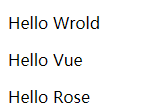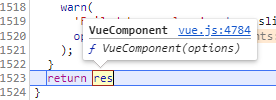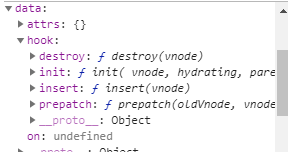组件是可复用的Vue实例,一个组件本质上是一个拥有预定义选项的一个Vue实例,组件和组件之间通过一些属性进行联系。
组件有两种注册方式,分别是全局注册和局部注册,前者通过Vue.component()注册,后者是在创建Vue实例的时候在components属性里指定,例如:
<!DOCTYPE html> <html lang="en"> <head> <meta charset="UTF-8"> <title>Document</title> <script src="vue.js"></script> </head> <body> <div id="app"> <child title="Hello Wrold"></child> <hello></hello> <button @click="test">测试</button> </div> <script> Vue.component('child',{ //全局注册 props:['title'], template:"<p>{{title}}</p>" }) var app = new Vue({ el:'#app', components:{ hello:{template:'<p>Hello Vue</p>'} //局部组件 }, methods:{ test:function(){ console.log(this.$children) console.log(this.$children[1].$parent ===this) } } }) </script> </body> </html>
渲染DOM为:

其中Hello World是全局注册的组件渲染出来的,而Hello Vue是局部组件渲染出来的。
我们在测试按钮上绑定了一个事件,点击按钮后输出如下:

可以看到Vue实例的$children属性是个数组,对应的是当前实例引用的所有组件的实例,其中$children[0]是全局组件child的实例,而children[1]是局部组件hello的实例。
而this.$children[1].$parent ===this输出为true则表示对于组件实例来说,它的$parent指向的父组件实例,也就是例子里的根组件实例。
Vue内部也是通过$children和$parent属性实现了组件和组件之间的关联的。
组件是可以无限复用的,比如:
<!DOCTYPE html> <html lang="en"> <head> <meta charset="UTF-8"> <title>Document</title> <script src="vue.js"></script> </head> <body> <div id="app"> <child title="Hello Wrold"></child> <child title="Hello Vue"></child> <child title="Hello Rose"></child> </div> <script> Vue.component('child',{ props:['title'], template:"<p>{{title}}</p>" }) var app = new Vue({el:'#app'}) </script> </body> </html>
渲染为:

注:对于组件来说,需要把data属性设为一个函数,内部返回一个数据对象,因为如果只返回一个对象,当组件复用时,不同的组件引用的data为同一个对象,这点和根Vue实例不同的,可以看官网的例子:点我点我
例1:
<!DOCTYPE html> <html lang="en"> <head> <meta charset="UTF-8"> <title>Document</title> <script src="vue.js"></script> </head> <body> <div id="app"> <child ></child> </div> <script> Vue.component('child',{ data:{title:"Hello Vue"}, template:"<p>{{title}}</p>" }) var app = new Vue({el:'#app'}) </script> </body> </html>
运行时浏览器报错了,如下:

报错的内部实现:Vue注册组件时会先执行Vue.extend(),然后执行mergeOptions合并一些属性,执行到data属性的合并策略时会做判断,如下:
strats.data = function ( //data的合并策略 第1196行 parentVal, childVal, vm ) { if (!vm) { //如果vm不存在,对于组件来说是不存在的 if (childVal && typeof childVal !== 'function') { //如果值不是一个函数,则报错 "development" !== 'production' && warn( 'The "data" option should be a function ' + 'that returns a per-instance value in component ' + 'definitions.', vm ); return parentVal } return mergeDataOrFn(parentVal, childVal) } return mergeDataOrFn(parentVal, childVal, vm) };
源码分析
以这个例子为例:
<!DOCTYPE html> <html lang="en"> <head> <meta charset="UTF-8"> <title>Document</title> <script src="vue.js"></script> </head> <body> <div id="app"> <child title="Hello Wrold"></child> </div> <script> Vue.component('child',{ props:['title'], template:"<p>{{title}}</p>" }) var app = new Vue({el:'#app',}) </script> </body> </html>
Vue内部会执行initGlobalAPI()函数给大Vue增加一些静态方法,其中会执行一个initAssetRegisters函数,该函数会给Vue的原型增加一个Vue.component、Vue.directive和Vue.filter函数函数,分别用于注册组件、指令和过滤器,如下
function initAssetRegisters (Vue) { //初始化component、directive和filter函数 第4850行 /** * Create asset registration methods. */ ASSET_TYPES.forEach(function (type) { //遍历//ASSET_TYPES数组 ASSET_TYPES是一个数组,定义在339行,等于:['component','directive','filter'] Vue[type] = function ( id, definition ) { if (!definition) { return this.options[type + 's'][id] } else { /* istanbul ignore if */ if ("development" !== 'production' && type === 'component') { validateComponentName(id); } if (type === 'component' && isPlainObject(definition)) { //如果是个组件 definition.name = definition.name || id; definition = this.options._base.extend(definition); //则执行Vue.extend()函数 ;this.options._base等于大Vue,定义在5050行 } if (type === 'directive' && typeof definition === 'function') { definition = { bind: definition, update: definition }; } this.options[type + 's'][id] = definition; //将definition保存到this.options[type + 's']里,例如组件保存到this.options['component']里面 return definition } }; }); }
Vue.extend()将使用基础Vue构造器,创建一个“子类”。参数是一个包含组件选项的对象,也就是注册组件时传入的对象,如下:
Vue.extend = function (extendOptions) { //初始化Vue.extend函数 第4770行 extendOptions = extendOptions || {}; var Super = this; var SuperId = Super.cid; var cachedCtors = extendOptions._Ctor || (extendOptions._Ctor = {}); if (cachedCtors[SuperId]) { return cachedCtors[SuperId] } var name = extendOptions.name || Super.options.name; if ("development" !== 'production' && name) { validateComponentName(name); } var Sub = function VueComponent (options) { //定义组件的构造函数,函数最后会返回该函数 this._init(options); }; /*中间进行一些数据的合并*/ // cache constructor cachedCtors[SuperId] = Sub; return Sub }; }
以例子为例,当加载完后,我们在控制台输入console.log(Vue.options["components"]),输出如下:

可以看到child组件的构造函数被保存到Vue.options["components"]["child“]里面了。
当vue加载时会执行模板生成的render函数,例子里的render函数等于:

执行_c('child',{attrs:{"title":"Hello Wrold"}})函数时会执行vm.$createElement()函数,也就是Vue内部的createElement函数,如下
function createElement ( //创建vNode 第4335行 context, tag, data, children, normalizationType, alwaysNormalize ) { if (Array.isArray(data) || isPrimitive(data)) { //如果data是个数组或者是基本类型 normalizationType = children; children = data; //修正data为children data = undefined; //修正data为undefined } if (isTrue(alwaysNormalize)) { normalizationType = ALWAYS_NORMALIZE; } return _createElement(context, tag, data, children, normalizationType) //再调用_createElement } function _createElement ( //创建vNode context, //context:Vue对象 tag, //tag:标签名或组件名 data, children, normalizationType ) { /*略*/ if (typeof tag === 'string') { //如果tag是个字符串 var Ctor; ns = (context.$vnode && context.$vnode.ns) || config.getTagNamespace(tag); if (config.isReservedTag(tag)) { //如果tag是平台内置的标签 // platform built-in elements vnode = new VNode( //调用new VNode()去实例化一个VNode config.parsePlatformTagName(tag), data, children, undefined, undefined, context ); } else if (isDef(Ctor = resolveAsset(context.$options, 'components', tag))) { //如果该节点名对应一个组件,挂载组件时,如果某个节点是个组件,则会执行到这里 // component vnode = createComponent(Ctor, data, context, children, tag); //创建组件Vnode } else { // unknown or unlisted namespaced elements // check at runtime because it may get assigned a namespace when its // parent normalizes children vnode = new VNode( tag, data, children, undefined, undefined, context ); } } else { // direct component options / constructor vnode = createComponent(tag, data, context, children); } if (Array.isArray(vnode)) { return vnode } else if (isDef(vnode)) { if (isDef(ns)) { applyNS(vnode, ns); } if (isDef(data)) { registerDeepBindings(data); } return vnode //最后返回VNode } else { return createEmptyVNode() } }
resolveAsset()用于获取资源,也就是获取组件的构造函数(在上面Vue.extend里面定义的构造函数),定义如下:
function resolveAsset ( //获取资源 第1498行 options, type, id, warnMissing ) { /* istanbul ignore if */ if (typeof id !== 'string') { return } var assets = options[type]; // check local registration variations first if (hasOwn(assets, id)) { return assets[id] } //先从当前实例上找id var camelizedId = camelize(id); if (hasOwn(assets, camelizedId)) { return assets[camelizedId] } //将id转化为驼峰式后再找 var PascalCaseId = capitalize(camelizedId); if (hasOwn(assets, PascalCaseId)) { return assets[PascalCaseId] } //如果还没找到则尝试将首字母大写查找 // fallback to prototype chain var res = assets[id] || assets[camelizedId] || assets[PascalCaseId]; //最后通过原型来查找 if ("development" !== 'production' && warnMissing && !res) { warn( 'Failed to resolve ' + type.slice(0, -1) + ': ' + id, options ); } return res }
例子里执行到这里时就可以获取到在Vue.extend()里定义的Sub函数了,如下:

我们点击这个函数时会跳转到Sub函数,如下:

回到_createElement函数,获取到组件的构造函数后就会执行createComponent()创建组件的Vnode,这一步对于组件来说很重要,它会对组件的data、options、props、自定义事件、钩子函数、原生事件、异步组件分别做一步处理,对于组件的实例化来说,最重要的是安装钩子吧,如下:
function createComponent ( //创建组件Vnode 第4182行 Ctor:组件的构造函数 data:数组 context:Vue实例 child:组件的子节点 Ctor, data, context, children, tag ) { /*略*/ // install component management hooks onto the placeholder node installComponentHooks(data); //安装一些组件的管理钩子 /*略*/ var vnode = new VNode( ("vue-component-" + (Ctor.cid) + (name ? ("-" + name) : '')), data, undefined, undefined, undefined, context, { Ctor: Ctor, propsData: propsData, listeners: listeners, tag: tag, children: children }, asyncFactory ); //创建组件Vnode return vnode //最后返回vnode }
installComponentHooks()会给组件安装一些管理钩子,如下:
function installComponentHooks (data) { //安装组件的钩子 第4307行 var hooks = data.hook || (data.hook = {}); //尝试获取组件的data.hook属性,如果没有则初始化为空对象 for (var i = 0; i < hooksToMerge.length; i++) { //遍历hooksToMerge里的钩子,保存到hooks对应的key里面 var key = hooksToMerge[i]; hooks[key] = componentVNodeHooks[key]; } }
componentVNodeHooks保存了组件的钩子,总共有四个:init、prepatch、insert和destroy,对应组件的四个不同的时期,以例子为例执行完后data.hook等于如下:

最后将虚拟VNode渲染为真实DOM节点的时候会执行n createelm()函数,该函数会优先执行createComponent()函数去创建组件,如下:
function createComponent (vnode, insertedVnodeQueue, parentElm, refElm) { //创建组件节点 第5590行 ;注:这是patch()函数内的createComponent()函数,而不是全局的createComponent()函数 var i = vnode.data; //获取vnode的data属性 if (isDef(i)) { //如果存在data属性(组件vnode肯定存在这个属性,普通vnode有可能存在) var isReactivated = isDef(vnode.componentInstance) && i.keepAlive; //这是keepAlive逻辑,可以先忽略 if (isDef(i = i.hook) && isDef(i = i.init)) { //如果data里定义了hook方法,且存在init方法 i(vnode, false /* hydrating */, parentElm, refElm); } // after calling the init hook, if the vnode is a child component // it should've created a child instance and mounted it. the child // component also has set the placeholder vnode's elm. // in that case we can just return the element and be done. if (isDef(vnode.componentInstance)) { initComponent(vnode, insertedVnodeQueue); if (isTrue(isReactivated)) { reactivateComponent(vnode, insertedVnodeQueue, parentElm, refElm); } return true } } }
createComponent会去执行组件的init()钩子函数:
init: function init ( //组件的安装 第4110行 vnode, //vnode:组件的占位符VNode hydrating, //parentElm:真实的父节点引用 parentElm, //refElm:参考节点 refElm ) { if ( //这是KeepAlive逻辑 vnode.componentInstance && !vnode.componentInstance._isDestroyed && vnode.data.keepAlive ) { // kept-alive components, treat as a patch var mountedNode = vnode; // work around flow componentVNodeHooks.prepatch(mountedNode, mountedNode); } else { var child = vnode.componentInstance = createComponentInstanceForVnode( //调用该方法返回子组件的Vue实例,并保存到vnode.componentInstance属性上 vnode, activeInstance, parentElm, refElm ); child.$mount(hydrating ? vnode.elm : undefined, hydrating); } },
createComponentInstanceForVnode会创建组件的实例,如下:
function createComponentInstanceForVnode ( //第4285行 创建组件实例 vnode:占位符VNode parent父Vue实例 parentElm:真实的DOM节点 refElm:参考节点 vnode, // we know it's MountedComponentVNode but flow doesn't parent, // activeInstance in lifecycle state parentElm, refElm ) { var options = { _isComponent: true, parent: parent, _parentVnode: vnode, _parentElm: parentElm || null, _refElm: refElm || null }; // check inline-template render functions var inlineTemplate = vnode.data.inlineTemplate; //尝试获取inlineTemplate属性,定义组件时如果指定了inline-template特性,则组件内的子节点都是该组件的模板 if (isDef(inlineTemplate)) { //如果inlineTemplate存在,我们这里是不存在的 options.render = inlineTemplate.render; options.staticRenderFns = inlineTemplate.staticRenderFns; } return new vnode.componentOptions.Ctor(options) //调用组件的构造函数(Vue.extend()里面定义的)返回子组件的实例,也就是Vue.extend()里定义的Sub函数 }
最后Vue.extend()里的Sub函数会执行_init方法对Vue做初始化,初始化的过程中会定义组件实例的$parent和父组件的$children属性,从而实现父组件和子组件的互连,组件的大致流程就是这样子